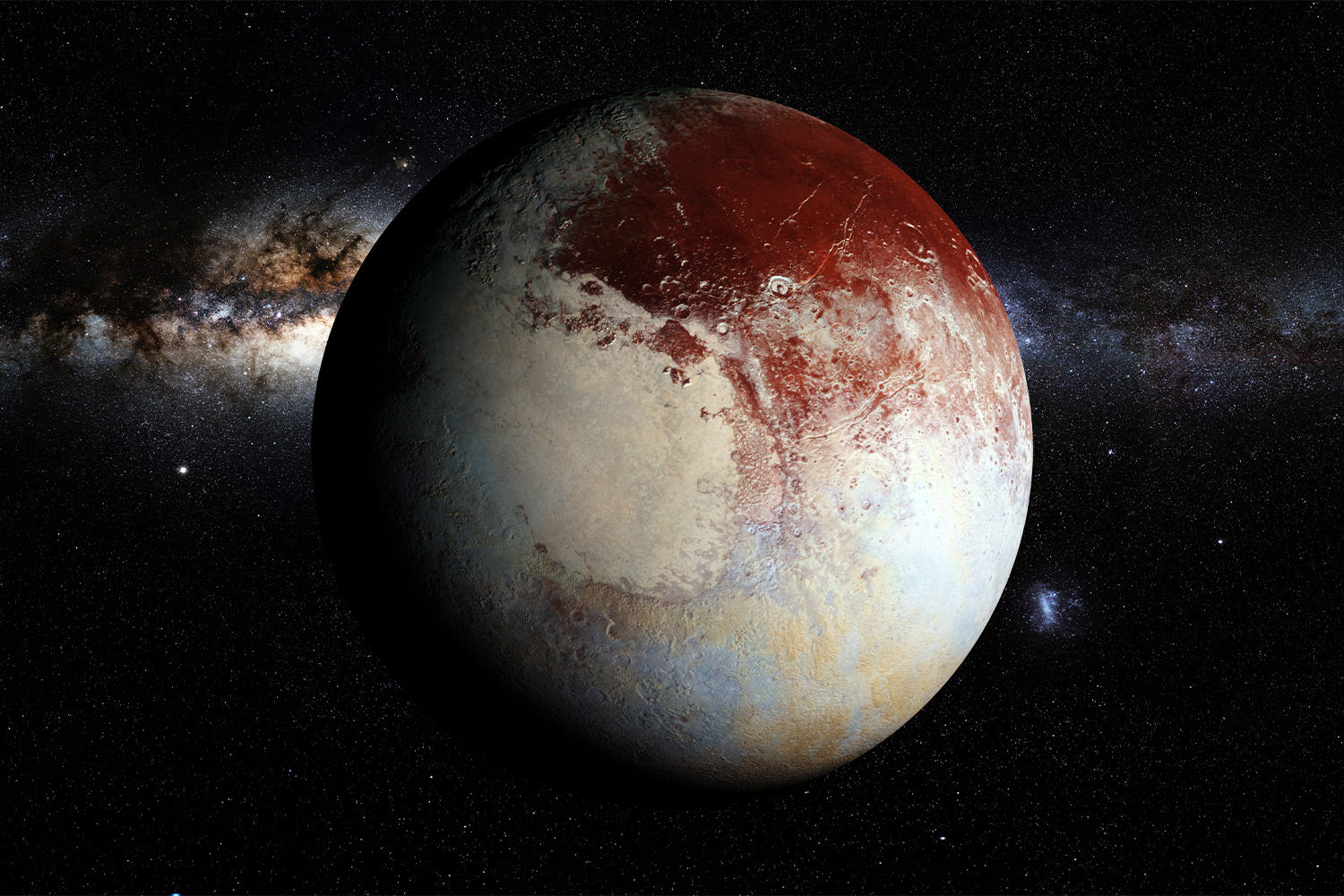
For more than seven wonderful decades, Pluto was our darling dearest ninth planet. The runt of the solar system with a moon half its size, we didn’t care that it was a small fry in a Milky Way full of large fries.
No one was bothered by its oddly tilted, oval-shaped orbit, and we were unphased by its ice queen demeanor. Covered in frozen gas (like methane and nitrogen) and shrouded in mystery, Pluto was a weirdo — but it was our weirdo, nonetheless.
Loved by many, the distant icy world was highly misunderstood and often thought of as a peculiar misfit in the sky. Yet despite its non-conformist ways, Pluto resonated with people far and wide. Kiddos could identify with its smallness, and adults related to its existence as an oddball.
Needless to say, the pint-sized ball of ice was pretty popular. But then, on one fateful day, everything changed: Pluto got the shaft and was no longer considered a planet. And the world went mad (obvi).
It’s been more than 15 years since the little guy got relabeled by NASA, but there’s still quite a bit of confusion surrounding the demotion. But don’t worry — Famous IRL is here to clear the air.
In this post, we’re exploring the solar system’s most controversial ruling to understand once and for all why Pluto is no longer a planet. So rev up your flying saucers for a flyby and get comfortable because we’re about to take off!
But First, What the Heck Is a Planet, Anyway?
If you’re like us, you probably learned about the nine planets in our vast solar system back in grade school. From Mercury to Pluto and all the celestial giants in between, you likely had to memorize the order and rattle them off at the drop of a hat.
Then, in 2006, tragedy struck when the International Astronomical Union (IAU) General Assembly set the official classification of what a planet actually was, and unfortunately, our beloved Pluto didn’t make the cut.
Causing massive waves of confusion to millennials everywhere, our understanding of the solar system was forever changed.
We had to undo what was drilled into our young brains from science class, textbooks had to be rewritten, and the public was outraged.
So, what exactly is a planet, you ask?
Well, according to the science nerds who gave Pluto the boot, for a planet to join the ranks of planethood, it must meet three conditions:
- It must orbit the sun.
-
It must be large enough and have sufficient mass that its own self-gravity molds it into a spherical shape.
- It must have an orbit free of other small objects.
Compared to all the planets we vibe with, Pluto was the only one that didn’t fit the bill.
Ok — Tell Me About Pluto
Pluto was discovered by the Lowell Observatory in Flagstaff, Arizona. Astronomers Clyde Tombaugh and William H. Pickering first saw this iconic rock in February of 1930.
The name Pluto comes from the naming advice of an 11-year-old girl in England. She recommended that this planet be named for the God of the Underworld.
We got closer to this iconic rook with NASA's New Horizons mission to the Pluto system (and further). NASA's New Horizons spacecraft finally got to the party in 2015, taking some epic photographs and making some amazing discoveries.
It’s hard not to feel bad for the ‘lil fella. Pluto doesn’t have the bling of Saturn’s rings. It lacks the infamous little green men of Mars. It’s not as bright as Venus, and it certainly isn’t as much fun to say as Uranus. But despite all that, most people will agree that the adorably small ball of ice definitely didn’t deserve to get demoted to a dwarf planet.
History and Mystery
Pluto lives amongst hundreds of thousands of asteroids that are totally iced out (aka— Kuiper Belt objects, aka trans-Neptunian objects). These orbit around the sun farther away than Neptune. When Clyde Tombaugh first happened upon Pluto, he naturally assumed it to be a planet. It was also initially believed to be much larger than Mercury and possibly even bigger than Earth.
Over the years, as telescopes got bigger and better, astronomers started to think that Pluto’s potentially massive size was a bit sus. But it wasn’t until the end of the 20th century when things got really weird, and they realized the former planet wasn’t alone.
In 1992, an enormous object about a tenth as wide as Pluto was seen orbiting out beyond it — and since then, more than 2,000 icy, rocky bodies have been found lurking in this frosty outskirt of the solar system dubbed the Kuiper Belt.
Discovering Pluto’s many neighbors raised a whole lot of questions. One of them being, "Should Pluto continue to be called the ninth planet?”
After many years of discussion and debate, it was finally decided in 2006 to kick Pluto out of the planet club. We’re so sad; we’re going to need some space from this nightmare.
Here’s why:
Reason #1: It’s Pretty Itty-Bitty
If Neptune were the size of a Chevy Impala, Pluto would be a matchbox car. In other words, the icy wonderland is pretty itty-bitty— even smaller than Earth’s moon.
If you ask us, size really doesn’t matter (wink, wink), but unfortunately, due to being so small, Pluto can’t clear its orbit and hence has a very busy neighborhood, thereby violating the definition of a planet.
In simpler terms, Pluto isn’t strong enough to kick out neighboring rigid body forces, meaning it isn’t gravitationally dominant in its region of space.
Reason #2: Its Orbit Is Erratic
While all the planets keep to their own lanes as they orbit the sun and move in the same plane like marbles rolling around a plate, Pluto is a bit of a trouble-maker and basically does its own thing.
You see, unlike the others, Pluto’s orbit is a bit odd and crosses the orbit of Neptune. It’s so eccentric and far from circular that it actually gets much closer to the sun than Neptune for 20 of its 248-year-long trip.
Due to its orbit being so different when compared to the rest of the Solar System, many scientists believe Pluto is closely similar to a comet or asteroid and shouldn’t really be considered a planet.
Reason #3: The “Official Definition” Stinks
The black sheep of planets in our solar system, Pluto, was demoted when a bunch of scientists came together to agree on an official planetary definition. The discussions were intense. By the last day of the assembly, it was voted to adopt a new resolution for outlining criteria for naming a planet.
As mentioned earlier, to join the elite and earn planetary status, a planet must orbit the sun, be spherical-shaped, and have cleared the neighborhood around its orbit.
For many reasons, this “official definition” stinks. Why? Well, for starters, it was made primarily to keep the number of “official” planets at a manageable number.
You see, if Pluto were to retain its status as a planet, then so too would everything else we find out in the shadowy Kuiper Belt that lies beyond Neptune. Before we know it, we’d have thousands of planets.
What’s more, Earth shares its cosmic turf with more than 12,000 asteroids, yet it's still considered a planet. Plus, very much like Earth, Pluto is a stunningly complex and diverse world with large mountains and vast nitrogen-ice plains. In other words, if Pluto isn’t considered a planet, then Earth technically shouldn’t be considered one either.
Lastly, out of around 10,000 internationally registered members of the Astronomical Union, only 237 haters voted to revoke Pluto’s club planethood membership, while 157 voted in favor of leaving the little planet alone.
The other 9,500 members weren’t even present, and yet, Pluto’s official planetary status was snatched away. Fair? We think not!
Planet or Not, We Love You, Pluto!
Another reason why Pluto isn’t a planet?
Simply put, if 7-8-9, then that leaves us with only eight planets. And seeing as Pluto is not-so-lucky number nine… Well, you see where we’re going with this. ;)
Here at Famous IRL, we don’t judge a planet based on whether it can clear its orbit or not, no sir. You see, back in our day, there were nine planets. Not eight, not seven — nine. And of the nine, the little icy orb was without a doubt our favorite.
We didn’t care how small or strange it was; we could identify with Pluto. It was wonderfully peculiar yet shrouded in mystery. And despite its weirdness, many folks all around the globe became huge fans of the solar system’s underdog.
Even to this day, after Pluto was stripped of its planetary status many years ago, we’re still rooting for the small cosmic body. In fact, to show our love for the distant frozen wonderland, we created an awesome t-shirt featuring Pluto.
Ready to represent the ninth planet in our Solar System? Check us out today and get your outer space on tomorrow. From tees and tanks to sweaters and hoodies, our premium quality apparel is out of this world.

Sources:
IAU 2006 General Assembly: Result of the IAU Resolution votes | Press Releases | IAU
The Earth is not a planet for the same reasons that Pluto is no longer considered as one | Technology News
Why is Pluto so different from the other planets? | HCMUT
Distant Object Hints at the Kuiper Belt | Science News
Overview | Kuiper Belt – NASA Solar System Exploration | Solar System
Scientists Say: Gravity | Science News For Students
Pluto’s Landscape Is More Like Earth’s Than Previously Thought | News

















Lexy panterra
September 18, 2024
yes I am B!TCH !!!!!